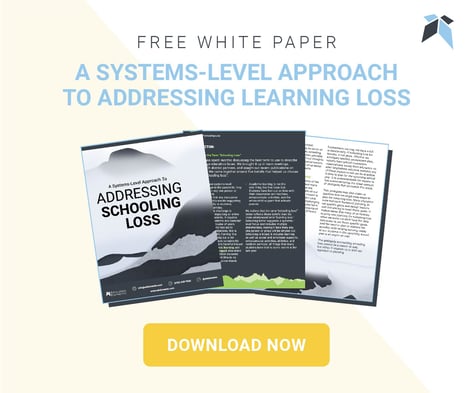Learning loss is the baby elephant in the room. It’s an issue that is currently small enough to briefly acknowledge, deprioritize, or ignore completely. Yet this elephant will continue to grow as the size and scale of learning loss due to the pandemic is better understood. The vaccine has returned a sense of hope that life will get back to “normal.” But educators must recognize that a return to “normal” will only reinforce the widening opportunity gap and systems that support institutionalized racism. Instead, structural changes will need to be made if learning loss is to truly be addressed. This conversation is critical as schools transition from virtual learning to in-person (and maybe back) this year, and begin planning for the summer and 2021-22 school year.
It is critical that learning loss be approached as a systemic issue and not a student, teacher, or family issue. The “loss” is the time schools and districts didn’t have with their students; the time to build relationships, knowledge, community, and skills. Learning is not a commodity. When we approach it as an issue facing students or teachers, whether intentional or not, we place responsibility (and often blame) on those individuals. Learning loss is a phenomenon of the pandemic, it is larger than any one person or group of people. The pandemic impacted our entire society in structural ways, and we must approach learning loss from a similarly structural approach.
Of the many changes that need to occur, there are four that educators should prioritize. Specifically, how might we:
-
Pivot to assessments that are faster, smaller, and more meaningful
-
Create acceleration opportunities that are in addition to the core curriculum
-
Approach social emotional learning as integral rather than additional
-
Embrace flexibility when it prioritizes student learning time
Pivot to learning assessments that are faster, smaller, and more meaningful
Data is only essential when it informs the work of schools and teachers. Traditional district-wide assessments can be cumbersome to implement, time-consuming, and may not impact classroom practices until weeks later, if ever. In practice, these assessments are often more meaningful for central office than they are for classroom teachers.
-
Teachers should focus on short formative assessments that can inform their practice immediately.
-
Schools should prioritize process over product; help teachers to implement formative assessments and use that data immediately (process), rather than spending time writing or planning for big assessments (product).
-
Districts should guard against as many infringements on learning time as possible. While some testing is important, there are other assessments that take-up time that could be better used on learning, and those often come as district mandates.
Create opportunities to accelerate learning in addition to the core curriculum
If opportunity gaps are to close, then students must have ample time with BOTH grade-level content and acceleration time. This cannot become an either/or conversation; if it does we risk remediating learning with the full knowledge that we may never give students the grade-level education they deserve. This requires an investment in time and money that will absolutely be a challenge that local, state, and national leaders must collectively advocate for.
-
Expand high-quality after-school, weekend, and summer programs with a successful track record of positively impacting student achievement.
-
Create a well-trained cohort of tutors to work with the students most in need of additional support.
Approach social emotional learning as integral rather than additional
Social emotional learning (SEL) is not a new program, it is simply good teaching. As the Collaborative for Academic, Social, and Emotional Learning (CASEL) has defined it, “SEL is the process through which all young people and adults acquire and apply ... knowledge, skills and attitudes.” SEL is not a program you can turn on and off or a lesson that can be skipped. It is the way we ensure students learn. Ignoring SEL to prioritize learning is a contradiction; learning cannot happen without it.
-
Expand foundational training for social emotional learning so that teachers, administrators, and staff all have a common understanding and use a common language
-
Ensure school and district leaders are modeling the SEL competencies they want to see in classrooms. Creating community and psychological safety in a classroom is much harder to do when it doesn’t exist amongst adults.
Embrace flexibility when it prioritizes student learning time
Distance learning has demonstrated that there are more opportunities outside of the school day and our brick-and-mortar building to teach students. However, it is important not to confuse flexibility as an instructional practice. More flexibility will not automatically lead to more achievement and too much change at once can overwhelm educators (as it would with anyone) – in turn furthering learning loss, rather than bridging the gap. Utilize flexibility when it facilitates additional learning and practice time or when it creates more opportunities for students to work directly with teachers.
-
Adaptive digital programs can create from curricular flexibility, ensuring that students work on the content that is most relevant to their needs
-
Distance learning can still exist alongside in-person learning, even when the pandemic has subsided. This tool can be especially valuable if it expands the amount of time students have to learn and work with their teacher and classmates
-
Consider piloting more innovative practices, such as mastery grading or competency based education, that can lead to more structural flexibility
Learning loss will be an issue educators will grapple with for years to come. Every school and district is unique with diverse strengths and areas of growth. These four considerations can serve as a starting point to spark the conversations and ideas that will ultimately lead to the structural changes necessary to support our students after the pandemic.
More Virtual Learning reading
Blog: Tips For Setting Up An At-Home Learning Environment For Young Students
Blog: Adaptations for Flexible Learning
Blog: What Do Students Need Right Now?
Blog: 7 Strategies to Develop Student Executive Functioning Skills for Remote Learning
Blog: Distance Learning Requires a Student-Centered Approach
Blog: Shifts in Professional Learning: more microlearning and virtual courses





